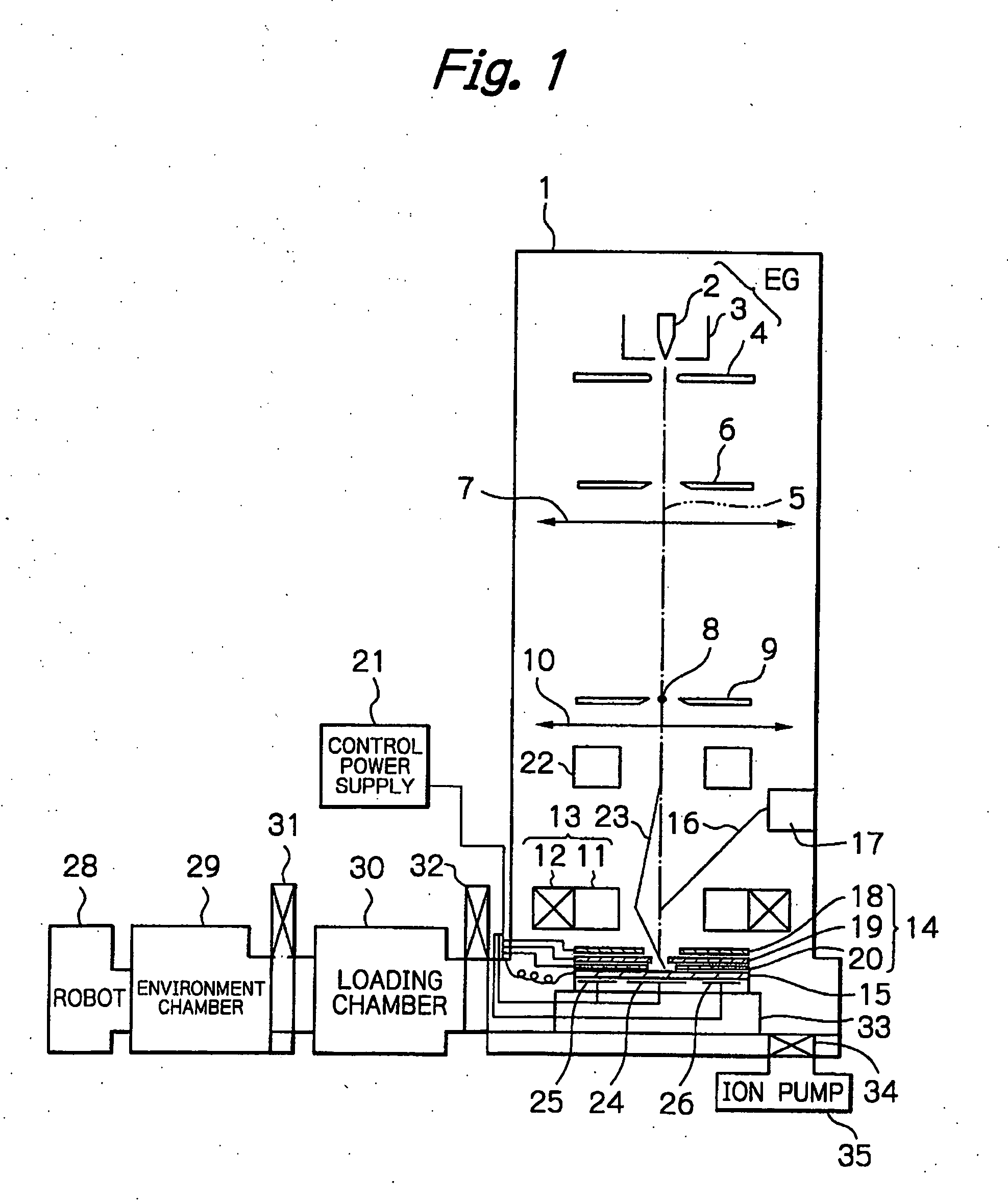Electron beam apparatus and device manufacturing method using same
a technology device, applied in the field of chromatic aberration coefficient, can solve the problems of large aberration coefficient of object lens, unsolved, complex overall apparatus, etc., and achieve the effect of reducing the axial chromatic aberration coefficient, simple structure, and performing in an extremely short tim
- Summary
- Abstract
- Description
- Claims
- Application Information
AI Technical Summary
Benefits of technology
Problems solved by technology
Method used
Image
Examples
first embodiment
[0065]FIG. 1 generally illustrates an electron beam apparatus according to the present invention. In FIG. 1, an electron-optical column 1 contains an electron gun EG comprised of a cathode 2, a Wehnelt 3, and an anode 4. A primary electron beam emitted from the electron gun EG is irradiated to a first aperture plate 6 having an aperture formed in square on condition that a cross-over 5 is created between the first aperture plate 6 and a first condenser lens 7. In this manner, the primary electron beam that has passed through shaping aperture plate 6 is reduced by the first condenser lens 7 to form a cross-over image 8 on a circular aperture of a second aperture plate 9. The primary electron beam is further reduced by a second condenser lens 10, and passes through an E×B separator 13 made up of an electrostatic deflector 11 and an electromagnetic deflector 12. Then, the primary electron beam is converged by an objective lens 14, and a reduced image of the square aperture formed throu...
second embodiment
[0090] Next, the electron beam apparatus according to the present invention will be described with reference to FIGS. 6 and 7. As illustrated in FIG. 6, the electron beam has a plurality (eight in the illustrated example) of electron-optical columns 100 identical in configuration, arranged side by side on a sample 82. One 101 of the electron-optical columns comprises an electron gun 110; alignment deflectors 74, 75 for aligning a primary electron beam; a condenser lens 76; an electrostatic deflector 77 for scanning the primary electron beam; an E×B separator 111 comprised of an electromagnetic deflector 79 and an electrostatic deflector 80; an objective lens 81; and detector 78 in a detection system for detecting a signal indicative of any of detected secondary electrons emitted from the sample 82, reflected electrons, or absorbed electrons.
[0091] The electron gun 110, which comprises a Wehnelt 72, a thermal electron emitting cathode 71, and an anode 73, emits the primary electron b...
third embodiment
[0102] Next, the electron beam apparatus according to the present invention will be described with reference to FIGS. 8 and 9. As illustrated in FIG. 8, the electron beam apparatus comprises an electron gun 170; alignment deflectors 144, 145 for aligning a primary electron beam; a condenser lens 146; an aperture 147 formed through a plate in a square shape; an NA aperture 159; a condenser lens 149; alignment deflectors 148, 160 for aligning the NA aperture 159 with condenser lens 149; an electrostatic deflector 150 for scanning the primary electron beam; an E×B separator 153 comprised of an electrostatic deflector 151 and an electromagnetic deflector 152; an objective lens 180 comprised of an upper electrode 154, a central electrode 155, and a lower electrode 156; and a secondary electron detector 158 in a detection system for detecting a signal indicative of detected secondary electrons emitted from a sample 157.
[0103] The electron gun 170, which mainly comprises a thermal electron...
PUM
| Property | Measurement | Unit |
|---|---|---|
| thickness | aaaaa | aaaaa |
| voltage | aaaaa | aaaaa |
| voltage | aaaaa | aaaaa |
Abstract
Description
Claims
Application Information
 Login to View More
Login to View More - R&D
- Intellectual Property
- Life Sciences
- Materials
- Tech Scout
- Unparalleled Data Quality
- Higher Quality Content
- 60% Fewer Hallucinations
Browse by: Latest US Patents, China's latest patents, Technical Efficacy Thesaurus, Application Domain, Technology Topic, Popular Technical Reports.
© 2025 PatSnap. All rights reserved.Legal|Privacy policy|Modern Slavery Act Transparency Statement|Sitemap|About US| Contact US: help@patsnap.com



